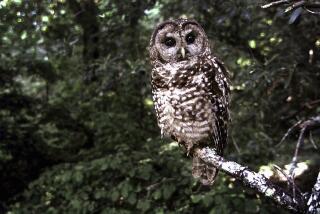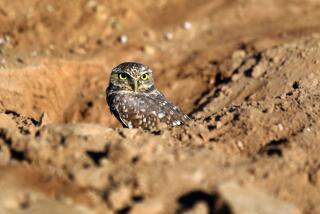Great horned owl
- Share via
BUBO VIRGINIANUS
While much of California waits out the deathly grip of winter, mating great horned owls fill the shadowy night with their haunting cries. In February, long before trees flush green with leaves, females take over abandoned hawk or crow nests and lay their two eggs. With males supplying their meals of rabbits and voles, females sit tight on their fragile eggs -- even if smothered under a thick blanket of snow. Mostly inconspicuous, only pointy ear tufts jutting over the nest rim give away their presence. The reward for nesting so early? Young owls come off the nest ready to hunt when the vulnerable babies of other birds and mammals are just being born.
*
NATURAL HISTORY
This astonishingly adaptable animal occupies every conceivable habitat type, from the northernmost edge of forest in the Arctic to the tip of South America. With exceptionally powerful legs and feet, these “winged tigers” can take down prey up to three times their weight, including raccoons, skunks and hawks.
*
KEY CHARACTERISTICS
The size of a large hawk, this nocturnal predator is best recognized by its broad facial disk and tall ear tufts.
More to Read
Sign up for The Wild
We’ll help you find the best places to hike, bike and run, as well as the perfect silent spots for meditation and yoga.
You may occasionally receive promotional content from the Los Angeles Times.





